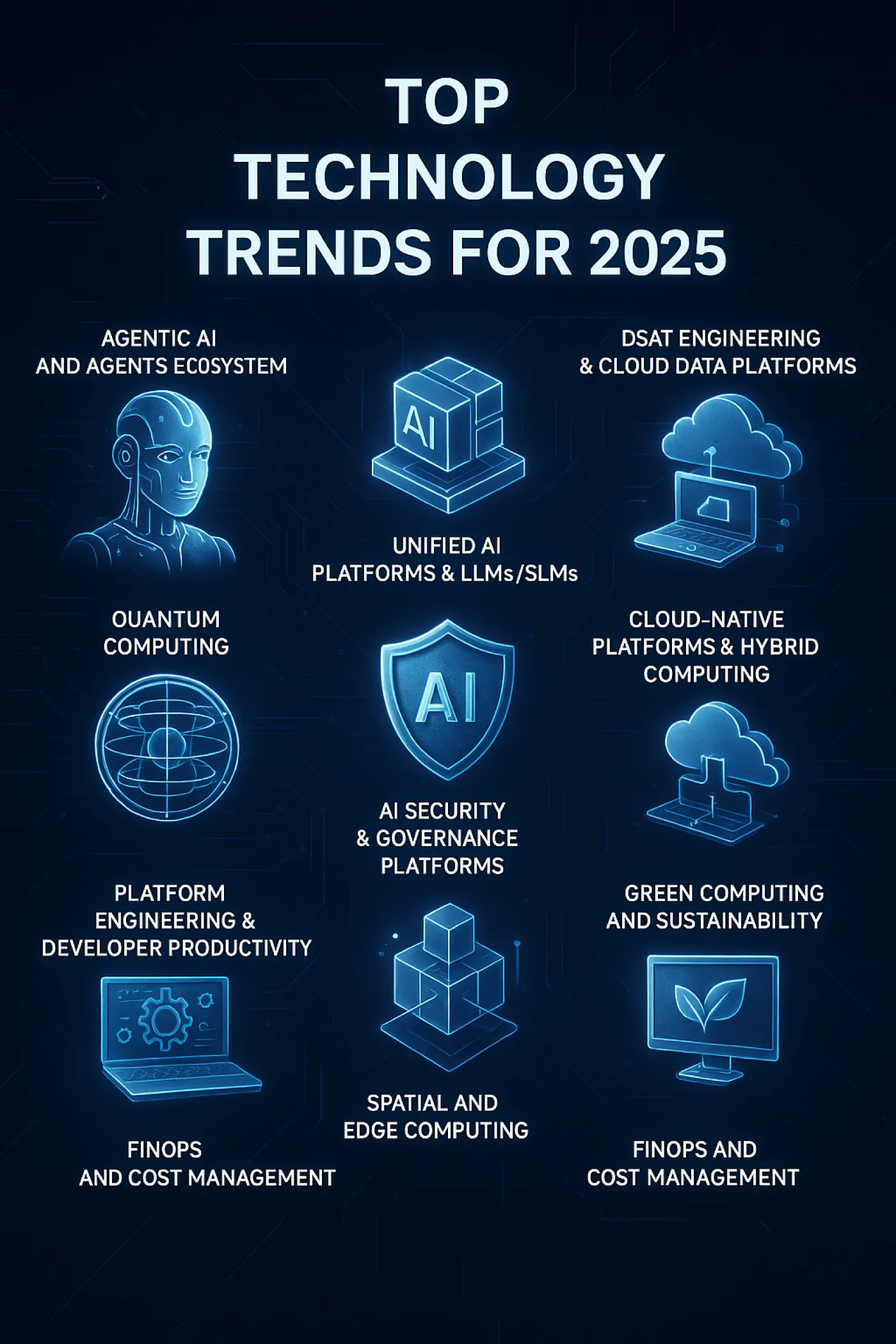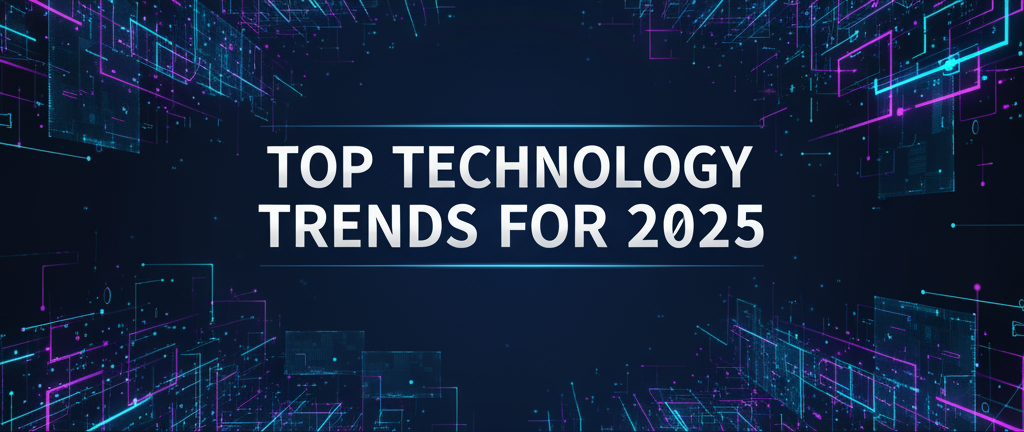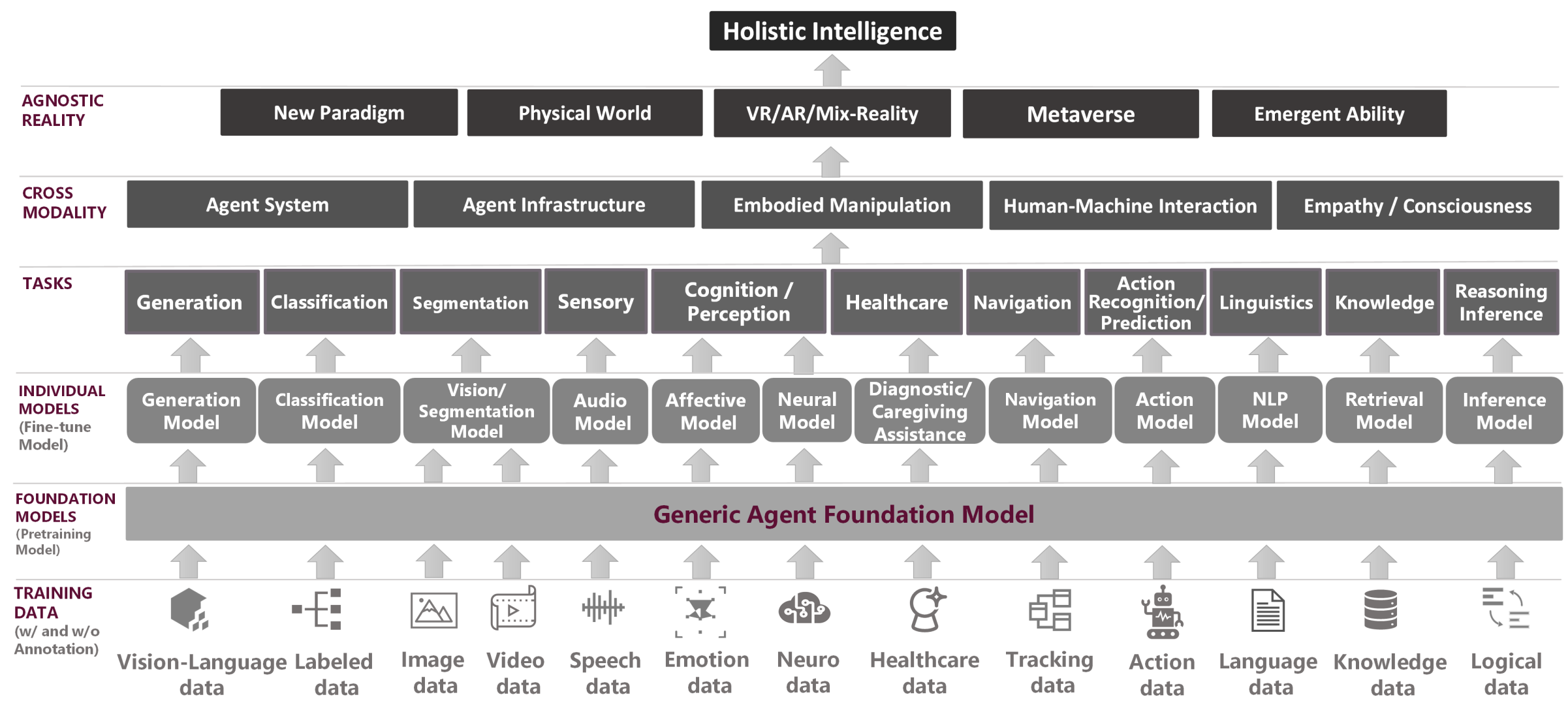Observing technology trends by analysts, research companies, and thought leaders creates awareness and helps build a broader perspective.
This article synthesizes the top ten technology trends for 2025 and beyond based on my broader research, technology insights, observations, and industry experience. Click on the corresponding links to read about the technology trends published for 2024, 2023, 2022, and 2021.
#1 — Agentic AI and Agents Ecosystem
By 2028, 33% of enterprise software applications will include agentic AI, up from less than 1% in 2024, enabling 15% of day-to-day work decisions to be made autonomously — Gartner.
- Agentic AI: It has emerged as a leading GenAI trend and will continue to evolve further in 2025 predicted as the key differentiator for higher productivity and efficiency. Agentic AI will be incorporated everywhere, including AI-based Personal Assistants, Business Workflows, SaaS platforms, IoT devices, Cloud Platforms, Operational Systems, Robotics, and many more. Many startups have built novel ideas empowered by Agentic capabilities,s revolutionizing the industry built with technologies such as LangGraph, CrewAI, LlamaIndex, AutoGPT, and more (read this blog for the complete list of Agentic frameworks). Solutions like Manus AI (released in Mar 2025) have revolutionized the potential of Agentic AI with the power of LLM + Tools + Reasoning to handle real-world use cases.
- Agentic Ecosystem: Hyperscalers and product companies are leading the trend by providing out-of-the-box capabilities and production-grade best practices in terms of Agent Orchestration & Workflow, Security guardrails, Responsible AI, Observability, LLM Integration, LLMOps/GenAIOps, LLM Evaluation, Enterprise Search, Semantic Search Capabilities, Tools Integration, etc. Google’s Agentspace, Azure AI Agent Service, Amazon Bedrock Agents, and Salesforce Agentforce are emerging platforms for building enterprise-grade AI Agents with such capabilities, enabling the industry to focus on solving business problems efficiently.
- Standardization of GenAI: Model Context Protocol emerged as the first commonly accepted industry standard across the big players to provide contextual data to LLMs in a vendor-neutral way. We will continue to witness similar standards or specifications related to Agentic AI and overall GenAI development. Agentic IDEs such as Cursor, Windsurf, Cline, and more have started supporting 100+ MCP Servers.
- Agents & MCP Marketplace: It enables businesses to discover Vertical Agents, Agent blueprints, and accelerators for diverse tasks such as AI-augmented software development, domain-service research, data analysis and document summarization, content creation, custom workflow automation, and many more. While there are vendor-driven Agents marketplaces (e.g. NVIDIA Blueprints, CrewAI Templates, LangGraph Studio, Hubspot Agent.ai, AI Agent Store, AI Agents Directory) an enterprise-specific Agents marketplace has emerged as a key priority for the 2025 roadmap and to reuse Agents within an enterprise ecosystem. Additionally, MCP Marketplaces and common MCP registries will continue to evolve in 2025, such as Smithery, OpenTools, MCP.so, Glama, and more.
- Building holistic intelligent systems using Agentic AI will continue to evolve in 2025 (a representation by a research paper illustrated below):
#2 — Unified AI Platforms & Large Language Models
The global AI platform industry is projected to witness a CAGR of 21.3% between 2024 and 2034 and is anticipated to reach USD 136.5 billion by 2034 end.
— Future Market Insights Report
- Convergence of Machine Learning, Data, Analytics, and AI Platforms: The Emergence of Unified AI Platforms has emerged as one of the major trends in 2025. Enterprises have diversified options to adopt either AI Cloud Platforms such as Google Vertex AI, Amazon Sagemaker, and Azure AI Foundry or Specialized AI Platforms like Palantir AIP, C3.ai, Dataiku, H2O.ai, DataRobot, Altair, Databricks, Snowflake for AI, IBM Watsonx, and many more. GPU-focused companies like NVIDIA have realized the potential of Enterprise AI platforms, and their emphasis on NeMo for building Models and NIM for deploying them signifies that.
- Maturity and Production-ready GenAI Solutions: The maturity of these products will enable Enterprises to accelerate building business capabilities in 2025 as technical features will be available out-of-the-box such as Enterprise RAG, Data Ingestion, Processing and Storage in Vector DB for Semantic Search, Hybrid Search, Governance and Security Guardrails, Tools Integration, Conversational AI, etc. The competitive landscape of LLMs will continue to evolve in 2025 with leading providers such as Google Gemini 2.0, OpenAI o1 & o3-mini, Anthropic Claude 3.5, Meta Llama 3, xAI Grok 3 (Beta), and DeepSeek-R1. Refer here for a comparison of these models’ price, performance, and intelligence with industry benchmarks.
- Rise of Reasoning & Cost-effective Open Source LLMs: The evolution of Llama and DeepSeek Models has started closing the gap between open-source and proprietary models, providing advanced reasoning, multilingual, cost-efficiency, and long-context capabilities. In 2025, we will continue to see more revolution in open-source AI since the launch of DeepSeek R1 in January 2025.
#3 — Data Engineering & Cloud Data Platforms
By 2026, the Use of Data-as-a-Product Architectures Will Significantly Break Down Data Silos in 50% of Large Enterprises — IDC FutureScape 2025
- Continuous Evolution with Data-as-a-Product: Applying domain-driven design principles, Data-as-a-Product has been gaining momentum and will continue to evolve in 2025, enabling various enterprise use cases. Enterprises will use “data advantage” to gain market share in the AI era, increasing the significance of data engineering practices in 2025. Quality of data, along with Systems of Trust and Systems of Context (in the age of Agentic AI, a term coined by Scott Brinker) provide the foundational building blocks for AI-augmented systems both qualitatively and quantitatively.
- Modernization of Data Engineering with Cloud and Open Standards: Leading Cloud Data Platform products such as Snowflake, Databricks, Google BigQuery, Amazon Redshift, Azure Synapse, Teradata, Cloudera, Confluent, and more — have already started converging Data and Generative AI strategies to provide a unified platform. Continuous modernization of the data stack with Cloud data platforms and adoption of open standards (e.g. alignment towards Apache Iceberg & Apache Parquet) will continue to evolve in 2025 in alignment with the Data and AI strategy for Enterprises. See below as a reference for an open source data engineering technologies stack by clicking here.
#4 — Cloud-Native Platforms & Hybrid Computing
By 2027, more than 50% of enterprises will use industry cloud platforms to accelerate their business initiatives, up from less than 15% in 2023 — Gartner
- Mainstream adoption of Cloud-native Technologies: Cloud-native platforms and technologies are in mainstream adoption and while the trend continues in 2025, vendor lock-in and open standards will continue to be prevalent in enterprise technology strategy. The Cloud Native Computing Foundation (CNCF), an open-source-driven community, fosters the adoption of cloud-native technologies and will continue to increase the adoption of these solutions in enterprises.
- Exploring Hybrid Cloud for Data Sovereignty: Enterprises are going to include private and hybrid cloud strategies to address concerns around data sovereignty, security, and regulatory compliance, particularly for sensitive workloads and data. This approach ensures that targeted applications are in-house while leveraging the cloud for tasks like data analytics and AI in alignment with enterprise governance strategy.
- AI Workload and Data Platforms: GenAI workloads have increased the demand for computing (particularly GPUs), network (higher bandwidth), and storage (providing training, inference data + vector embeddings), and Cloud players will continue to leverage the potential in 202,5 providing support to the enterprises.
#5 — Quantum Computing
We believe quantum computing breakthrough will allow us to create a truly meaningful quantum computer not in decades, but in years. When productivity rises, economies grow faster, benefiting every sector and every corner of the globe. — Satya Nadella
- Quantum computing in the exploratory stage: While quantum computing is not completely mainstream yet for enterprises, Cloud platform companies will continue to invest — Microsoft’s announcement about Majorana 1 chip carves a new path in 2025 igniting a big shift in the technology landscape.
- Co-existing of quantum computing with cloud & classic computing: While researchers recognize the transformative impact and potential, the consensus is that quantum is not going to replace classical computing — acknowledging that it is not a silver bullet. 2025 will continue to see exploratory solutions being driven primarily by niche product companies to be prepared for the future.
- Securing data for the quantum computing era: Future-proofing enterprise systems to ensure that data remains secure in the quantum computing era (particularly for PII data) will be the subject of discussion and experimentation in 2025.
#6 —AI Security & Governance Platforms
By 2028, enterprises using AI governance platforms will achieve 30% higher customer trust ratings and 25% better regulatory compliance scores than their competitors — Gartner.
- Emergence of GenAI Security Governance Standards & Adherence: Open source communities such as OWASP have established standards for LLM Risks & Recommended Mitigations for LLMs and Gen AI Apps. Enterprises will enforce practices to implement threat modeling, security guardrails, and related practices in 2025 for production-ready GenAI Apps following enterprise security guidelines.
- Protecting against AI-generated Cyberattacks and AI-powered threats, such as deepfake phishing and future quantum computing: Enterprise security mechanisms continue to invest in advanced tools and technologies from a security perspective developing deepfake defense mechanisms, and post-quantum cryptography threats.
- Maintaining control over AI systems and data is critical, encompassing data privacy, security, performance, and cost (AI sovereignty): Gartner’s prediction indicates that AI Governance platforms will help manage control over AI systems and that’s why Enterprises will continue to invest in governance platforms. This includes comprehensive AI practices covering Ethical, Responsible, Transparency, Accountability, Fairness, and Privacy aspects of governance.
#7 — Platform Engineering & Developer Productivity
Thirty percent of teams will accelerate the SDLC with TuringBots. TuringBots are AI- and generative AI-infused development tools that automate and generate artifacts as well as assist development teams.
— Forrester Predictions 2025
- Continuous Evolution of Platform Engineering: 2025 is about building resilient, intelligent, cost-efficient, sustainable, and autonomous platform engineering systems, empowering developers’ experience (DevEx) to the next level. AI agents and Copilots will accelerate this journey with automation in focus, improving organizational efficiency to standards not experienced before.
- Focus on Productivity Measurement and Impact of GenAI: Tools for software engineering intelligence, like LinearB, provide data-driven insights to improve the developer experience and productivity by tracking key productivity metrics and automating the metric collection. The impact of GenAI on Software Development has been highlighted by the DORA report addressing developers’ concerns. Strategies highlighted as — being transparent about the organization’s GenAI strategy, allowing ample time for developers to learn how to use AI, creating policies that govern the adoption of AI, and addressing developer concerns about AI’s impact.
- Vibe Coding has emerged as a software development practice leveraging AI agents to build solutions more efficiently, taking productivity to a new level in 2025. Developer skills play a role in agentic coding. Read more about it on Martin Fowler’s website.
“Vibe coding” refers to a growing practice where you might barely look at the generated code, and instead focus on the architecture and features of your application. However, contrary to popular belief, effectively coding this way isn’t done by just prompting, accepting all recommendations, and hoping for the best. It requires structuring your work, refining your prompts, and having a systematic process that lead to a more efficient and effective workflow — Andrew Ng
- Adoption of Automation & Novel Technologies: While GenAI assistants and AI Agents will continue to demonstrate the impact of automation on DevSecOps and platform-related activities, modernizing existing enterprise technologies will continue to be a focus for organizations in 2025. Platform Engineering Org’s platform tooling landscape provides a useful reference for novel and applied technologies:
#8 — Spatial and Edge Computing
Spatial computing is trending due to advances in augmented reality (AR), mixedreality (MR) and AI technologies, enabling immersive digital environments acrossgaming, healthcare and e-commerce. With major companies like Nvidia and Qualcomm building ecosystems, the market is projected to grow from $110 billion in 2023 to $1.7 trillion by 2033.
— Gartner
- Immersive experience with Spatial Computing: Spatial computing augments the physical world with digital content for immersive consumer interaction, and 2025 will continue to see the advancement in this area. Big tech companies (Apple, Meta, NVIDIA, Google, Microsoft) will continue to bet bigger on Spatial Computing for immersive user experience.
- Apple’s Vision Pro (as a Spatial computing Headset), Meta’s Quest Series/Orion (as Augmented AI glasses), NVIDIA’s Omniverse (as a platform for Physical AI-enabled 3D apps), Google’s Project Starline (as high-fidelity telepresence system), and Microsoft’s HoloLens Series (as a mixed reality headset) are great product examples in Spatial Computing. The industry will continue to observe bigger announcements and experiments in 2025, expanding business use cases for immersive devices.
- Edge computing with processing data closer to the source: Edge computing enables data to be processed closer to its source and continues to be a key technology for building low-latency applications. The rise of Small Language Models (SLMs) will further strengthen capabilities for providing user experience powered by GenAI and will help promote design for building apps that can handle resource-constrained devices with edge computing.
#9 — Green Computing and Sustainability
Green computing aligns your digital transformation with sustainability. The rise of compute-intensive technologies such as AI coupled with increasing sustainability requirements are driving demand for energy-efficient computing — a package of technologies and applications that reduce IT systems’ energy consumption — Gartner.
- Energy-efficient computing: The rise of compute-intensive workload in 2025 necessitates focus on sustainability, driving demand for energy-efficient computing — a package of technologies and applications that reduce IT systems’ energy consumption. Energy-efficient computing (aka green computing) includes incremental tactics such as adopting greener energy or switching to more efficient hardware, and long-term strategies enabled by novel technologies.
- Sustainability and Energy Innovators: 2025 continues the trend of investment by big tech companies into leading energy innovators particularly for supporting AI workloads. Data center power usage continues its upward trend, leading to increased focused by regulators on building energy-efficient solutions to reduce carbon footprints. As per the tech predictions report by AWS, sustainability-focused positions are among the fastest-growing job categories across the US and Europe.
#10 — FinOps and Cost Management
Forrester predicts that in 2025, FinOps practices will expand beyond cloud spending to encompass the financial implications of AI and SaaS applications.
- Expansion of FinOps Ecosystem: Cloud Cost optimization has been a key focus area for enterprises driving the applicability of FinOps and Cost management practices. FinOps and Cost management practices will expand towards GenAI to justify the ROI and optimize the cost for GenAI technologies. FinOps Foundation Framework (illustrated below) helps the cause and will extend toward GenAI Cost Optimization techniques.
- FinOps-CloudOps-AIOps Collaboration: Convergence of overall cost of solution, providing a unified view of cost for building enterprise applications, will continue to be the focus area for executive stakeholders. Automation of Cost Insights will be a key priority in 2025, particularly considering the changing dynamics of the applications landscape in the era of GenAI-centric software development.
To extend the above list further, these are also the technology trends to watch for:
- Decentralization, Metaverse, Blockchain, and Web 3.0
- Augmented and Virtual Reality, Extended Reality (XR)
- Confidential Computing (a cloud computing technology that protects data during processing using techniques such as hardware-based TEE — trusted execution environment)
- Industry Cloud (cloud computing platform specifically designed to cater to the unique needs and challenges of a particular industry)
- Post-quantum cryptography (PQC refers to cryptographic methods designed to be secure against the potential quantum threats)
- Privacy Enhanced Computation (a combination of technologies providing fundamental data protection principles by minimizing personal data use)
- Disinformation Security (increasing the need for security measures to identify and prevent the spread of harmful content and verify authenticity)
- Ambient Invisible Intelligence (widespread use of small, low-cost tags and sensors to track the location and status of various objects and environments)
- Neurological Enhancement (the process of improving a human’s cognitive abilities using technologies that read and decode brain activity and optionally write to the brain)
To conclude, these technology trends for 2025 will continue to have a significant presence in modern enterprises’ technology strategy, driven by the context of the organizational functional and non-functional objectives. Feel free to share your perspective in the comments.

References:
- Gartner Top 10 Strategic Technology Trends for 2025
- Forrester Predictions 2025: Technology and Security
- Werner Vogels’ Tech Predictions for 2025 and Beyond
- 12 Days of OpenAI
- CB Insights Tech Trends for 2025
- IDC FutureScape 2025 IT Industry Predictions
- Publicis Sapient’s Guide to Next 2025 Industry Report
- Technology Radar by ThoughtWorks (Vol 31–2024)
Disclaimer:
All data and information provided on this blog are for informational purposes only. The author makes no representations as to the accuracy, completeness, correctness, suitability, or validity of any information on this blog and will not be liable for any errors, omissions, or delays in this information or any losses, injuries, or damages arising from its display or use. This is a personal view and the opinions expressed here represent my own and not those of my employer or any other organization.


